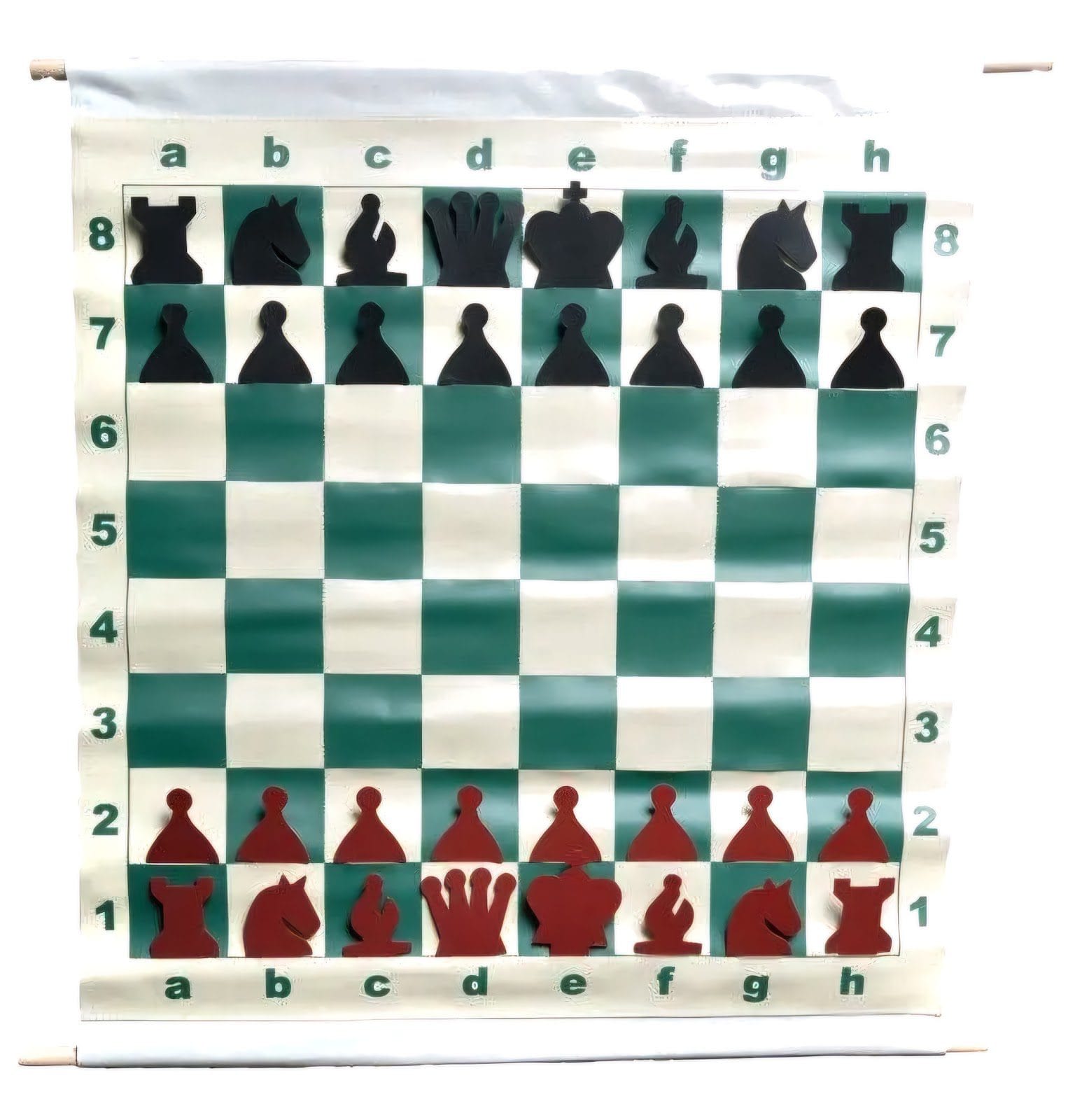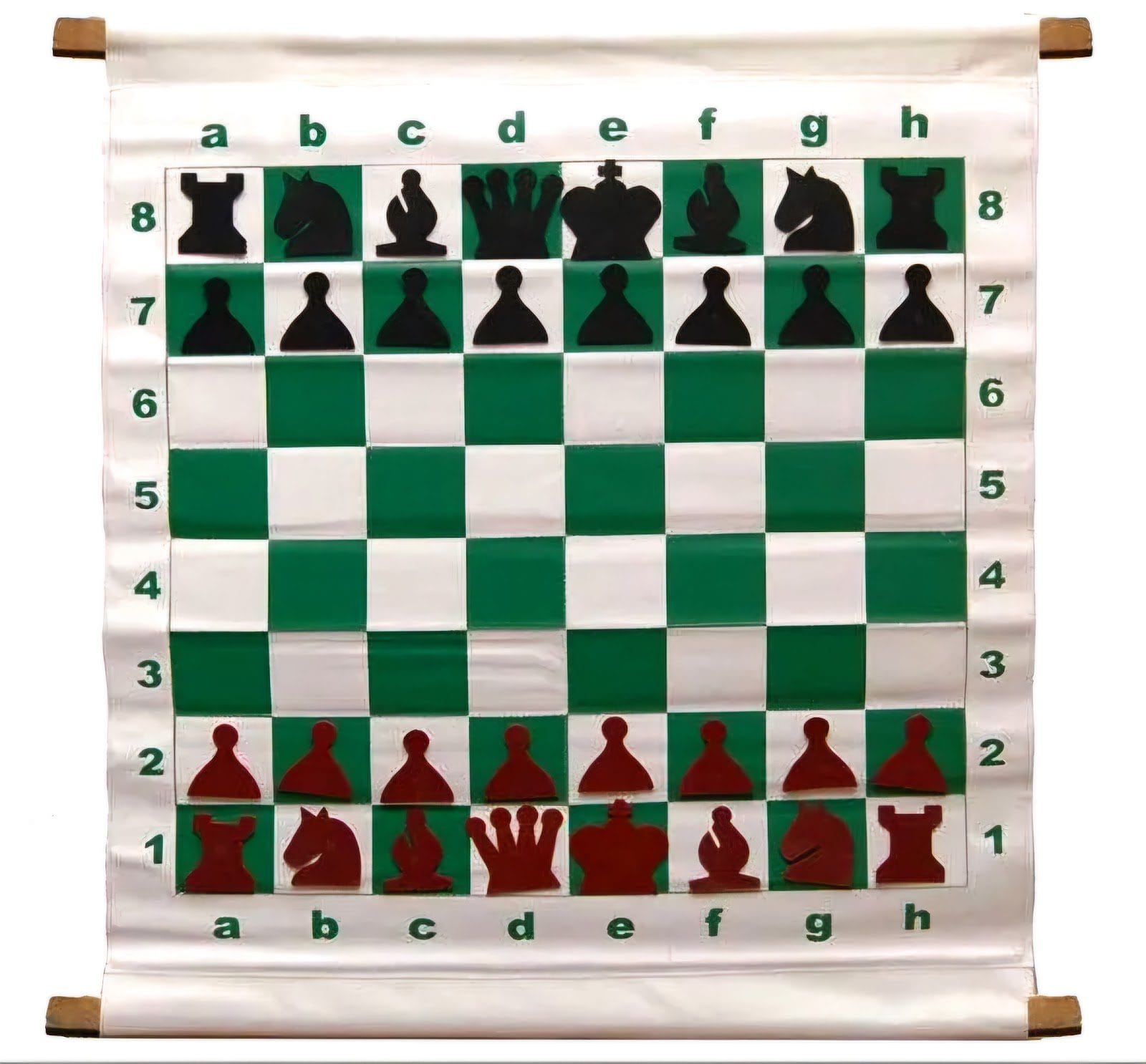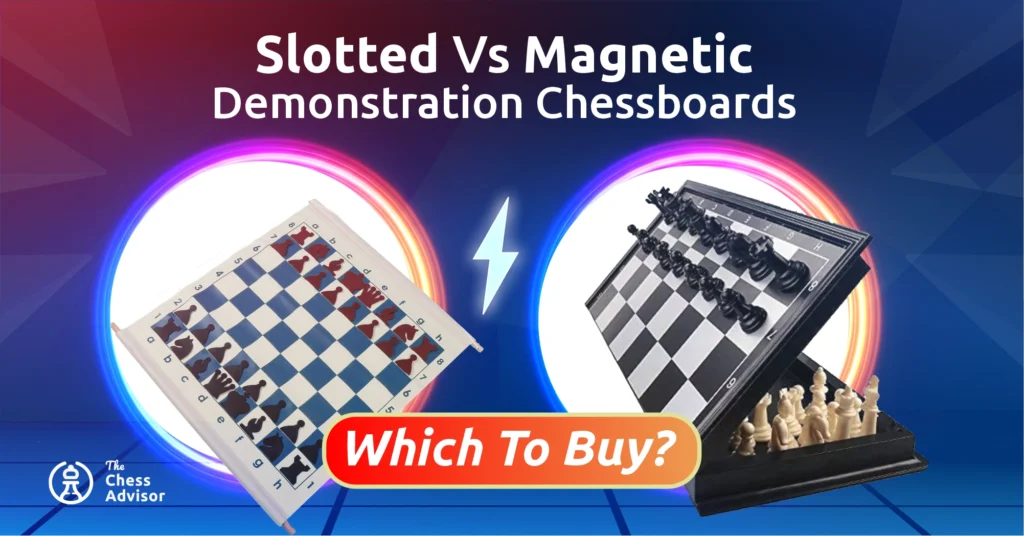If you’ve ever taught chess to a group, run a camp, or stood in front of a classroom trying to explain an opening, you know the power of a good demonstration board.
But choosing one? That’s where it gets tricky. The two big contenders in the demonstration board world are slotted and magnetic chessboards.
So, which one should you get? Let’s break it down.
What Are Demonstration Chessboards?
Before we get into details, it is important to know what demonstration chessboards are.
Demonstration boards, often called demo boards, are oversized chessboards designed for teaching or displaying positions to a group of people. You’ll usually see them hanging on walls in classrooms, chess clubs, or tournament halls.
Each square on the board is large enough to fit clearly visible pieces, either magnetic or slotted. The pieces are laid out so that an instructor can show chess moves in real-time while everyone watches.
Now that you know what they are, we can go into the two types of demo boards: the Magnetic and Slotted Demonstration Boards.
What Are Slotted Demonstration Boards?
Slotted demonstration boards are the classics. You’ve probably seen them hanging in school gyms, chess clubs, or tournament halls. They’re made from vinyl or fabric, with horizontal slots for pieces to slide into. The pieces themselves have little tabs that fit into the slots.
They’re old-school. But they work.
Pros of Slotted Boards
- Lightweight and foldable: Most slotted boards roll up like a vinyl tournament board. Great for travel.
- Durable: They don’t have any electronics or moving parts, just a simple structure that lasts for years.
- Outdoor friendly: Since pieces are physically held in place by slots, they won’t fall off due to wind or vibrations.
Cons of Slotted Boards
- Setup takes time: Each piece must be carefully slid into its place.
- Wear and tear: Tabs on the pieces can fray or tear with time, especially with frequent use.
- Not the fastest for live teaching: Making quick adjustments or changing a position mid-lesson can feel clunky.
What Are Magnetic Demonstration Boards?
Magnetic demo boards are the modern upgrade. Instead of slots, they use magnetic pieces that stick directly to a metal or magnetized surface.
They’re slick, professional, and easy to set up.
Pros of Magnetic Boards
- Quick setup and changes: Just slap the pieces on the board and you’re ready to go. Switching positions is fast and painless.
- Clean visual presentation: Magnets stay flat and are easy to read from a distance.
- Perfect for classrooms: It is ideal for schools, lecture halls, or online teaching, with a wall-mounted board behind you.
Cons of Magnetic Boards
- Bulkier to carry: Many come in rigid frames, which means more to pack.
- Not great for breezy environments: A gust of wind can knock pieces off if you’re teaching outside.
- Magnets wear out over time, especially in cheaper models, where the magnetic hold gets weaker with heavy use.
Which One Should You Choose?
Now that we know what the two demo boards are, which one is the best for you?
- For on-the-go coaches, consider a slotted board. You can roll it up, toss it in your bag, and teach anywhere, indoors or outdoors.
- Are you a classroom teacher or club organizer? A magnetic board will serve you better. It sets up faster and looks sharp on a whiteboard or wall.
- Are you on a tight budget? Slotted boards tend to be more affordable. You’ll save a bit, especially if you buy multiple sets.
- Need speed and flexibility? Magnetic wins here. It’s the go-to for fast-paced lessons where positions shift quickly.
Side-by-Side Comparison: Slotted vs Magnetic.
| Feature | Slotted Boards | Magnetic Boards |
| Setup Speed | Slower to set up | Faster to set up |
| Portability | Rolls up easily | Bulkier, harder to pack |
| Visual Clarity | Classic, but older feel | Sleek, modern look |
| Durability | High durability, but the tabs wear over time | Depends on magnet quality |
| Ease of Use | Can be fiddly | It’s more user-friendly |
| Best for | Outdoor or club travel | Indoor classrooms and lectures |
Our Picks For Both
Now that you know a bit about both boards, we’ve selected one of each for you.
28″ Slotted-Style Vinyl Demonstration (Teaching) Board Set with Deluxe Carrying Bag

The 28-inch Slotted-Style Demo Board
Price: $29.95
If you’re looking for a no-fuss, reliable demo board to teach, analyze, or show games to a group, this is your set.
The 28-inch Slotted-Style Vinyl Demonstration Board is designed for clarity and simplicity. The 3-inch squares are easy on the eyes, and the red-and-black pieces stand out, even from the back of a classroom or tournament hall.
It’s supported by two sturdy wooden dowels, one at the top and one at the bottom, which keeps the board from curling or sagging. There’s also a strong hanging cord so you can hook it onto a wall, whiteboard, or even a coat rack.
Transport is easy too. It comes with a heavy-duty nylon bag, complete with a solid zipper and adjustable strap. You can simply toss it over your shoulder, and you are ready to teach anywhere.
28″ Magnetic-Style Chess Demonstration (Teaching) Board Set with Deluxe Carrying Bag

The 28-inch Magnetic-Style Demo Board
Price: 35$
The 28″ Magnetic Demo Board is built for classrooms, clubs, and tournament analysis. It uses strong magnets instead of slots, so no more fiddling with pieces or watching them slide off mid-lesson. Setup is quick. Adjustments are smooth. It just works.
The squares are a solid 3-inch, easy to follow from across the room. The red and black pieces are bold, large, and legible, which is exactly what you need when explaining positions to a group.
The set includes a rugged carrying bag that zips shut and holds everything in place. It’s made from heavy-duty fabric and has an adjustable strap for easy transport.
Final Verdict
There’s no one-size-fits-all answer. The demo board you choose will be dependent on the style of teaching you want to adopt. It’s entirely up to you.
